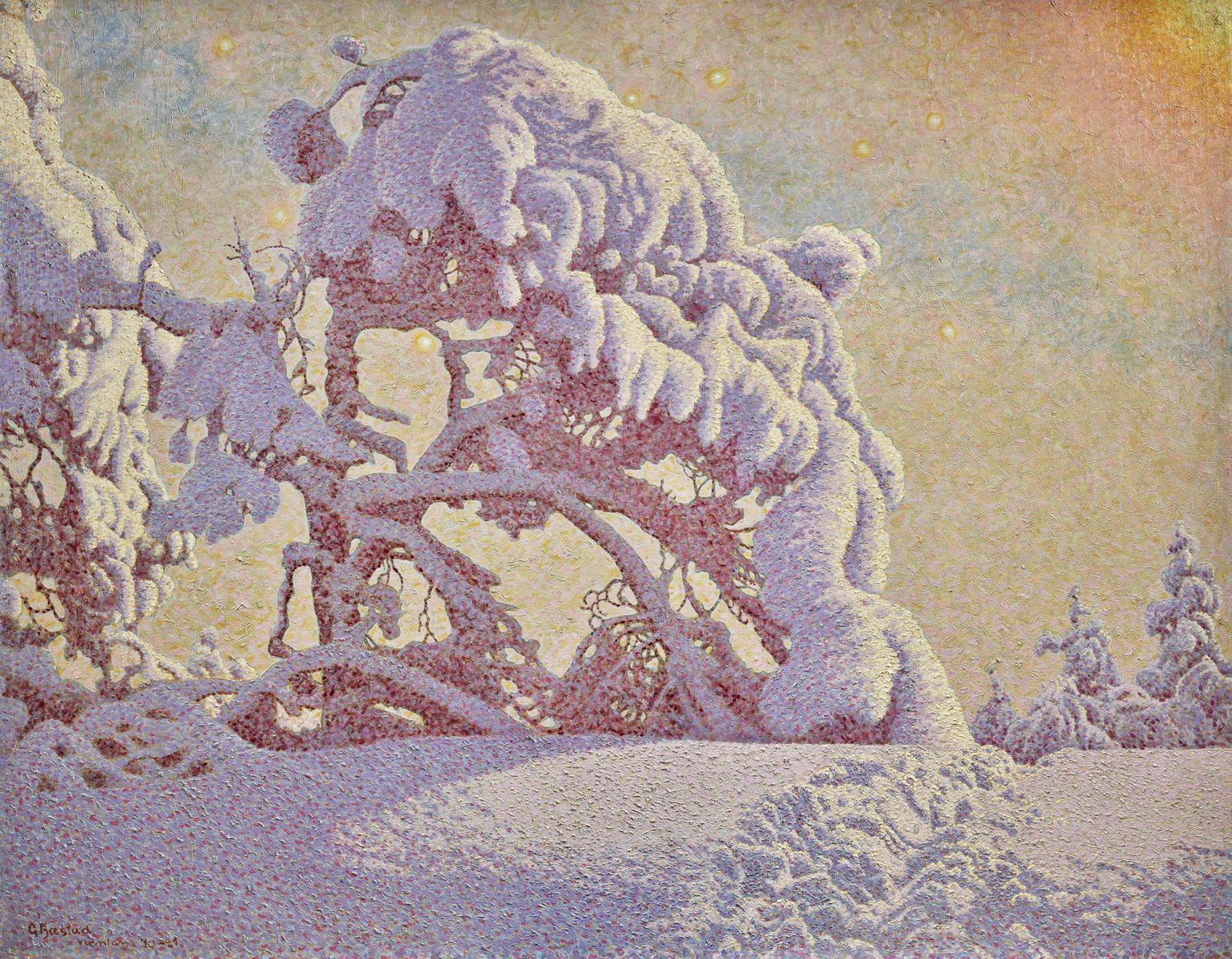
Signed and dated lower left: G Fjæstad | Vermland 20-21
Gustaf Fjæstad, nicknamed the “Master of Snow”, dedicated his entire life to painting the snowy landscapes of Sweden where he was born and lived out his life. He was a pupil of Bruno Liljefors, a famous and influential wildlife painter. He also studied with the painter Carl Larsson and helped him complete the fresco murals now at the Nationalmuseum – the national gallery of Sweden. He exhibited for the first time in 1897. By the age of thirty, he was already acclaimed as one of Sweden’s leading artists, having exhibited numerous snowscapes at the Stockholm Artists’ Union in 1898. That same year, Fjæstad married the talented young artist Maja Hallèn. Together, they founded an original group of artists, the Rackstad Colony, by Lake Racken in the heart of unspoiled nature near Arvika in the province of Värmland on the border with Norway. However, Gustaf was to achieve his greatest success on the international art scene. The first to appreciate his delicate winter depictions were German art lovers and critics; while in Rome his paintings were presented at the 1911 International Exhibition of Art, deeply impressing Italian collectors and even King Victor Emmanuel, who bought one of his paintings. These words have been attributed to the King of Italy: “When I look at his landscapes I feel the silence of the snow!” Such is the sense of identification that one experiences in front of his works. The strength of his paintings is that they were able to find in these frozen landscapes a unique metaphysical and emotional power, without ever becoming repetitive; just like the Eskimos, who, legend has it, have hundreds of words to indicate “ice”. Frost and winter were his original hallmark. He painted outdoors in the surrounding landscapes and forests in search of a special light, exploring the serenity of untouched beauty and a deep sense of mysticism. Fjæstad’s creative process, like that of his wife and artist Maja, was strongly influenced by the Theosophical spiritual movement, a precursor to today’s New Age movement. Paintings that portrayed nature in its purest form became a way of expressing universal enlightenment and eternal truth. In the specific context of “emotional art”, an expression that fully captures the general sense of the Symbolist process, the painting The snow proposed here is a typical example. In contemplating the canvas, the viewer is slowly lulled into a kind of meditative state of mind, accompanied by a fascinating sensation of bewitching magic, the feeling of a childlike fairy tale. A calming, sweet sensation far from clichés or superficiality. At first glance the image looks like a delicate and decorative tracery of lace-like snowflakes and curved, graceful lines typical of Art Nouveau. But immediately afterwards one perceives a deeper and more universal sense emerging from the silence of the snowy forest, a desire to live in harmony with nature, a search for inner peace that Fjæstad, a true loner, in all probability was only able to find in the purest and most unspoiled Nordic territory. A twilit, highly evocative atmosphere, unique and representative of the Northern European Symbolism of that period. Fjæstad’s technique too was unusual: this painting was created using photosensitive chemicals which, combined with Fjæstad’s mastery of the pointillist technique with much impasto, allowed him to represent the whiteness with extraordinary optical effects. The artist would coat his canvas with light-sensitive chemicals and project an image of the scene onto it as a preliminary map of light, which he would then use to complete the painting by hand. The colour was laid on the canvas in thick layers, allowing the artist greater control over the play of light. Shades of red, blue and grey let the colours vibrate on the canvas, denoting a strong influence of such neo-impressionist painters as Georges Seurat. A clear imprint of Art Nouveau is also visible in the soft, rolled and ornamental shapes of the snow. Proof positive that the artist had abandoned the 19th-century style of depicting landscapes, anticipating the more modern forms of the future. His works can be admired in the following museums: Nationalmuseum of Stockholm; Toledo Museum of Art, Ohio; Musée d’Orsay, Paris; Gothenburg Museum of Art, Sweden; Art Institute of Chicago.